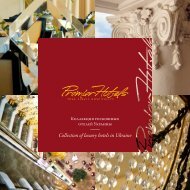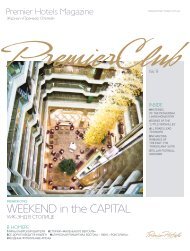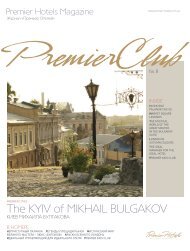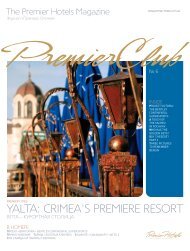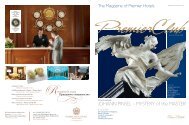Create successful ePaper yourself
Turn your PDF publications into a flip-book with our unique Google optimized e-Paper software.
Возводили собор константинопольские мастера. Об этом<br />
свидетельствуют византийские строительные и художественные<br />
приемы. Но работы нельзя было осуществить<br />
только силами приезжих, поэтому привлекли и русских мастеров.<br />
Прямых аналогов Софийскому храму нет ни в Константинополе,<br />
ни в других византийских городах: киевскому<br />
собору суждено было стать главным храмом Руси.<br />
Приехавшим в Киев константинопольским мастерам надлежало<br />
возвести огромный храм с большими хорами для проведения<br />
торжественных церемоний княжеского и епископского<br />
дворов. Мраморные детали, украшавшие собор в древности,<br />
были привезены князем Владимиром из Херсонеса. Полы выполнили<br />
из местного сланца (красного шифера).<br />
show scenes from the life <strong>of</strong> the Blessed Virgin, plus the Acts <strong>of</strong> the<br />
Apostles, and scenes from the lives <strong>of</strong> St. Michael and St. George.<br />
Considering the Byzantine construction and artistic methods<br />
used, the cathedral was built by masters from Constantinople.<br />
However, that city’s craftsmen alone could not have accomplished<br />
such a vast amount <strong>of</strong> work by themselves; therefore many Ruthenian<br />
craftsmen are also believed to have been engaged in the<br />
work. In addition, no direct parallel to St. Sophia’s existed either<br />
in Constantinople or elsewhere in the Byzantine Empire. It is<br />
assumed the <strong>Kyiv</strong>an cathedral was intended to become the main<br />
Christian shrine <strong>of</strong> the Ruthenian lands.<br />
The masters <strong>of</strong> Constantinople who came to <strong>Kyiv</strong> were tasked<br />
with erecting a huge temple with a spacious<br />
choir l<strong>of</strong>t to host solemn religious<br />
ceremonies led by members <strong>of</strong> the ducal<br />
and episcopal courts. The marble parts<br />
decorating the cathedral in ancient times<br />
were brought by Prince Volodymyr from<br />
the city <strong>of</strong> Chersonese in Crimea, while<br />
the floors were paved using local slate.<br />
The cathedral mainly consists <strong>of</strong> brickwork<br />
and natural stone fixed together using<br />
a special type <strong>of</strong> mortar solution. The<br />
cathedral’s restorers have left several areas<br />
<strong>of</strong> the ancient stonework uncovered for<br />
visitors to understand how the cathedral<br />
looked centuries ago. The architectural<br />
plan <strong>of</strong> the cathedral is rich in symbolism:<br />
the high central dome suggests Christ<br />
as the head <strong>of</strong> the Church, while the 12<br />
smaller domes are associated with the<br />
Apostles, with the four largest dedicated<br />
to the Evangelists. The exterior <strong>of</strong> the<br />
cathedral was altered following restoration<br />
works in the 17th and 18th centuries; external<br />
galleries and additional domes (now<br />
totalling 19) were built and the cathedral<br />
painted white. The ancient hemispherical<br />
domes were replaced with the pyriform<br />
cupolas typical <strong>of</strong> Ukrainian baroque style.<br />
premier<br />
cities<br />
18<br />
Собор был выложен из кирпича, в качестве связующего<br />
раствора использовали розовую цемянку. Чтобы можно<br />
было представить его прежний облик, на фасадах реставраторы<br />
оставили участки раскрытой древней кладки.<br />
Архитектурное решение собора имело свою символику.<br />
Центральный высокий купол храма в византийской архитектуре<br />
напоминал о Христе – главе<br />
церкви. 12 меньших куполов ассоциировались<br />
с апостолами, а четыре из<br />
них – с евангелистами. После реставраций<br />
XVII–XVIII веков облик собора<br />
изменился: появились наружные<br />
галереи, дополнительные купола<br />
(сейчас их 19), храм побелили. Купола<br />
Numerous pictures <strong>of</strong> saints adorn the<br />
columns <strong>of</strong> the cathedral and the walls <strong>of</strong><br />
its galleries. An ancient fresco in the western<br />
part <strong>of</strong> the central nave, still partially<br />
visible today, shows portraits <strong>of</strong> Prince<br />
Volodymyr as the founder <strong>of</strong> the cathedral<br />
together with his wife, Princess Anna <strong>of</strong> Byzantium, plus their sons<br />
and daughters. The frescoes also depict scenes from the life <strong>of</strong> the<br />
princely court, including the horserace track in Constantinople,<br />
musicians and a hunt. Scholars actively debate the musical instrument<br />
depicted on one cathedral wall: some argue it is a picture <strong>of</strong><br />
an old pneumatic pipe organ as a part <strong>of</strong> an orchestra that played<br />
during dance performances.<br />
Nearly 100 tombs rest inside the cathedral and nearby, including<br />
the white marble tomb <strong>of</strong> Prince Yaroslav the Wise. The cathedral<br />
was razed by Golden Horde <strong>of</strong> Genghis Khan in 1240 but<br />
was rebuilt under Metropolitan Cyprian over 1385-1390. Later,<br />
though somewhat poorer, restorative works took place in the<br />
centuries that followed. St. Sophia’s Cathedral was assumed by the<br />
18<br />
Spring ‘11




